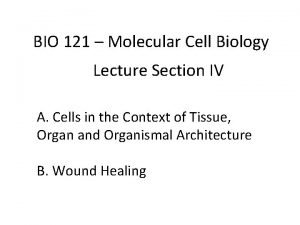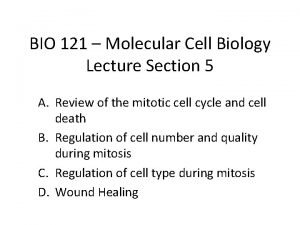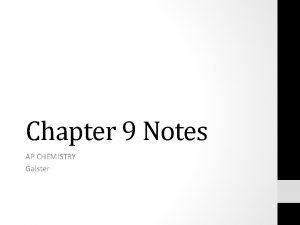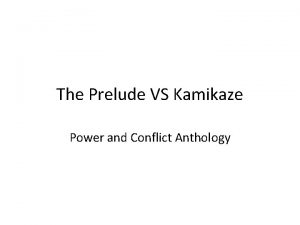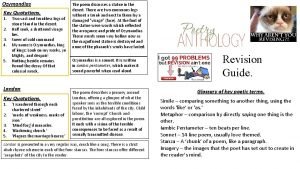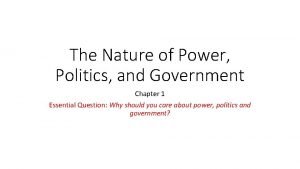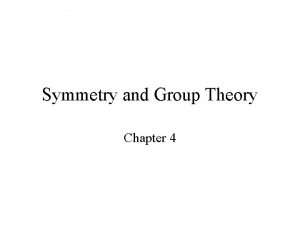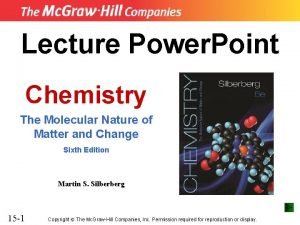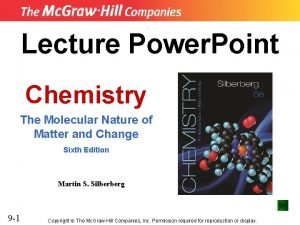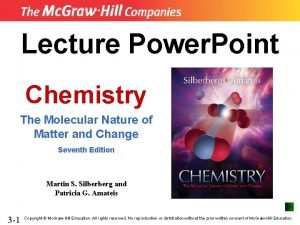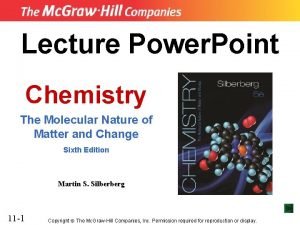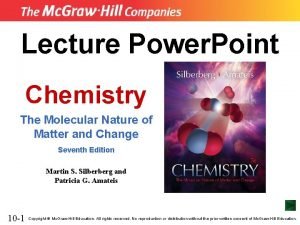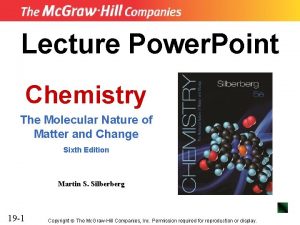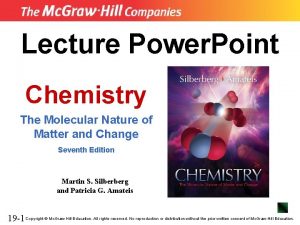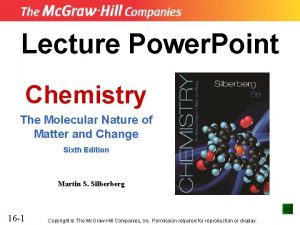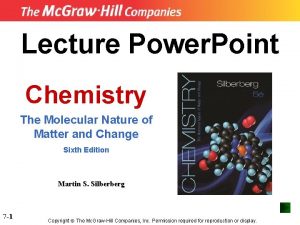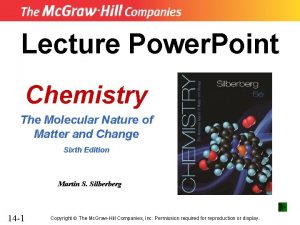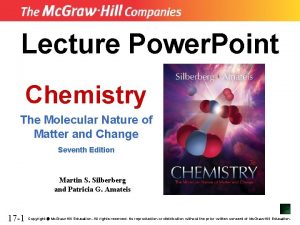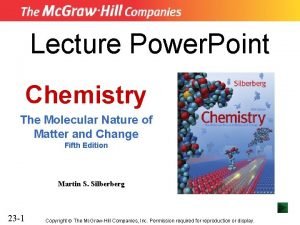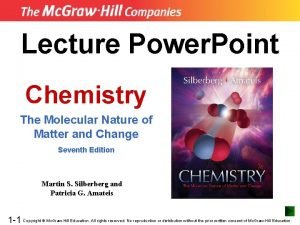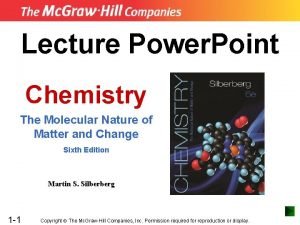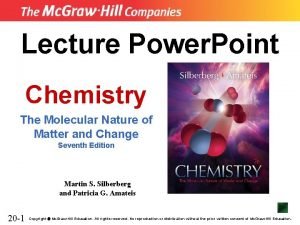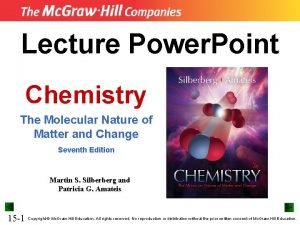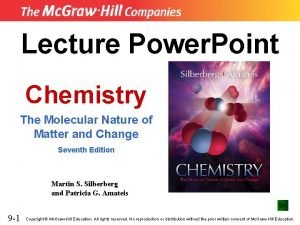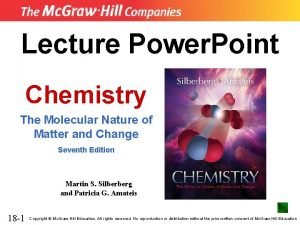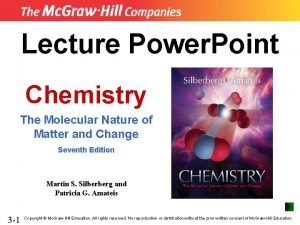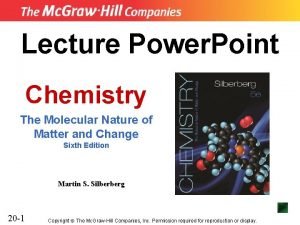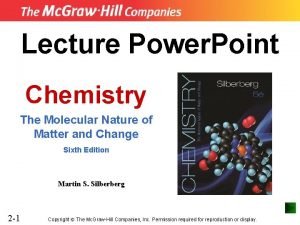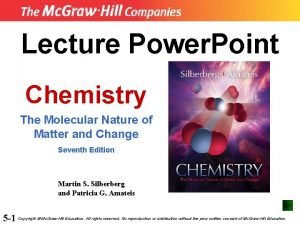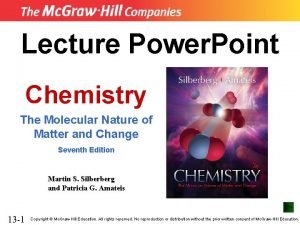Lecture Power Point Chemistry The Molecular Nature of











































































- Slides: 75

Lecture Power. Point Chemistry The Molecular Nature of Matter and Change Sixth Edition Martin S. Silberberg 24 -1 Copyright The Mc. Graw-Hill Companies, Inc. Permission required for reproduction or display.

Chapter 24 Nuclear Reactions and Their Applications 24 -2

Nuclear Reactions and Their Applications 24. 1 Radioactive Decay and Nuclear Stability 24. 2 The Kinetics of Radioactive Decay 24. 3 Nuclear Transmutation: Induced Changes in Nuclei 24. 4 Effects of Nuclear Radiation on Matter 24. 5 Applications of Radioisotopes 24. 6 Interconversion of Mass and Energy 24. 7 Applications of Fission and Fusion 24 -3

Table 24. 1 Comparison of Chemical and Nuclear Reactions Chemical Reactions Nuclear Reactions One substance is converted into another, but atoms never change identity. Atoms of one element typically are converted into atoms of another element. Electrons in orbitals are involved as bonds break and form; nuclear particles do not take part. Protons, neutrons, and other nuclear particles are involved; electrons in orbitals take part much less often. Reactions are accompanied by relatively small charges in energy and no measurable changes in mass. Reactions are accompanied by relatively large charges in energy and measurable changes in mass. Reaction rates are influenced by Reaction rates depend on number of temperature, concentration, catalyst, and nuclei, but are not affected by the compound in which an element occurs. temperature, catalysts, or, except on rare occasions, the compound in which an element occurs. 24 -4

Components of the Nucleus Most of the mass of the atom is concentrated in the dense, tiny nucleus. The nucleus comprises the neutrons and protons, collectively called nucleons. The total number of nucleons in a nucleus gives its mass number. A nuclide is a nucleus with a particular composition. Each isotope of an element has a different nuclide. A particular nuclide is often designated by its mass number; for example, chlorine-35 and chlorine-37. 24 -5

Notation for Nuclides The relative mass and charge of a particle is described by the notation: A = mass number Z = charge of the particle Example: electron proton neutron 24 -6 A Z X 0 e -1 1 p 1 1 n 0

Radioactivity Many nuclides are unstable and spontaneously emit radiation, a process termed radioactive decay. - The intensity of the radiation is not affected by temperature, pressure, or other physical and chemical conditions. When a nuclide decays, it emits radiation and usually changes into a nuclide of a different element. There are three natural types of radioactive emission: Alpha particles (α, 42 α , or 42 He ) are identical to helium-4 nuclei. Beta particles (β, β-, or 0 -1β ) are high-speed electrons. Gamma rays (γ or 00 γ ) are very high-energy photons. 24 -7

Figure 24. 1 How the three types of radioactive emissions behave in an electric field. The positively charged α particles curve toward the negative plate, the negatively charged β particles curve towards the positive plate, and the γ rays are not affected by the electric field. 24 -8

Nuclear Equations When a nuclide decays, it forms a daughter nuclide of lower energy. The excess energy is carried off by the emitted radiation and the recoiling nucleus of the daughter nuclide. The decay process is represented by a balanced nuclear equation. Both the total charge and the total mass must be balanced: Total A Reactants Total Z 24 -9 = Total A Total Z Products

Modes of Radioactive Decay • Alpha (α) decay involves the loss of an α particle from the nucleus. – For each α particle emitted, A decreases by 4 and Z decreases by 2 in the daughter nuclide. – This is the most common form of decay for a heavy, unstable nucleus. 228 222 4 Ra → Rn + 88 86 2α • β- decay involves the ejection of a β- particle from the nucleus. – A neutron is converted to a proton, which remains in the nucleus, and a β- particle is expelled: 1 n → 1 p + 0 β 0 1 -1 – A remains the same in the daughter nuclide but Z increases by 1 63 63 0 unit. Ni → Cu + 28 29 -1 β 24 -10

• Positron (β+) emission is the emission of a β+ particle from the nucleus. – The positron is the antiparticle of the electron. – A proton in the nucleus is converted into a neutron, and a positron is emitted: 1 1 0 p → n + β 1 0 1 – A remains the same in the daughter nuclide but Z increases by 1 unit. 11 11 0 C → B + 6 5 1β • Electron capture occurs when the nucleus interacts with an electron in a low atomic energy level. – A proton is transformed into a neutron: 1 p 1 + -10 e → 0 1 n – The effect on A and Z is the same as for positron emission. 24 -11

• Gamma (γ) emission involves the radiation of highenergy γ photons. – Gamma emission usually occurs together with other forms of radioactive decay. – Several γ photons of different energies can be emitted from an excited nucleus as it returns to the ground state. – γ emission results in no change in either A or Z since γ rays have no mass or charge. 24 -12

Table 24. 2 Modes of Radioactive Decay* 24 -13

Table 24. 2 Modes of Radioactive Decay* 24 -14

Sample Problem 24. 1 Writing Equations for Nuclear Reactions PROBLEM: Write balanced equations for the following nuclear reactions: (a) Naturally occurring thorium-232 undergoes α decay. (b) Zirconium-86 undergoes electron capture. PLAN: We first write a skeleton equation that includes the mass numbers, atomic numbers, and symbols of all the particles on the correct sides of the equation, showing the unknown A product particle as Z X. Then, because the total of mass numbers and the total of charges on the left side and the right side of the equation must be equal, we solve for A and Z, and use Z to determine the identity of X from the periodic table. 24 -15

Sample Problem 24. 1 SOLUTION: (a) Writing the skeleton equation, with the α particle as a product: 232 90 Th A →Z X + 4 2 α For A, 232 = A + 4, so A= 228. For Z, 90 = Z + 2, so Z = 88. The daughter nuclide produced in this reaction is Ra. 232 90 Th → 228 88 Ra 4 + 2α (b) Writing the skeleton equation, with the captured electron as a reactant: 86 0 A For A, 86+ 0 = A so A= 86. Zr + e → 40 -1 ZX For Z, 40 -1 = Z so Z = 39. Element X is yttrium, symbol Y. 86 40 Zr 24 -16 + 0 -1 e → 86 39 Y

Nuclear Stability Two key factors determine the stability of a nuclide: - the number of neutrons (N), the number of protons (Z), and their ratio (N/Z), and - the total mass of the nuclide. A plot of number of neutrons vs. number of protons for all stable nuclides produces a band of stability that gradually curves above the line for N = Z. - Lighter nuclides are stable when N = Z. - As Z increases, the N/Z for stable nuclei gradually increases. - All nuclides with Z > 83 are unstable. 24 -17

Figure 24. 2 24 -18 A plot of number of neutrons vs. number of protons for the stable nuclides.

Stability and Nuclear Structure Protons within the nucleus experience electrostatic repulsive forces, which destabilize the nucleus. The strong force, which exists between all nucleons, counteracts the weaker repulsive forces. Nucleons are found in nucleon energy levels, and pairing of the spins of like nucleons leads to greater stability. - Elements with an even Z (number of protons) usually have a larger number of stable nuclides. - Over half the stable nuclides have both even N and even Z. 24 -19

Table 24. 3 Number of Stable Nuclides for Elements 48 to 54* * 24 -20 Element Atomic No. (Z) No. of nuclides Cd 48 8 In 49 2 Sn 50 10 Sb 51 2 Te 52 8 I 53 1 Xe 54 9 Even Z shown in boldface.

Table 24. 4 An Even-Odd Breakdown of the Stable Nuclides Z N No. of nuclides Even 157 Even Odd 53 Odd Even 50 Odd 4 TOTAL 264 24 -21

Sample Problem 24. 2 Predicting Nuclear Stability PROBLEM: Which of the following nuclides would you predict to be stable and which radioactive? Explain. 18 (a) 10 Ne 32 (b)16 S (c) 236 90 Th (d) 123 56 Ba PLAN: In order to evaluate the stability of each nuclide, we determine the N and Z values and the N/Z ratio. We can then compare these to the values for stable nuclides. We also note whether Z and N are even or odd. SOLUTION: (a) 18 Ne is Radioactive. This nuclide has N = (18 – 10) = 8 and Z = 10, so the N/Z ratio is 18 – 10 = 0. 8, which is too low to be stable. 10 24 -22

Sample Problem 24. 2 (b) 32 S is stable. This nuclide has N = Z = 16, so N/Z = 1. 0. With Z < 20 and even values for N and Z, this nuclide is most likely stable. (c) 236 Th is radioactive. This nuclide has Z = 90, and every nuclide with Z < 83 is radioactive. (d) 123 Ba is radioactive. This nuclide has N = 67 and Z = 56, so N/Z = 1. 20. For Z values of 55 to 60, Figure 24. 2 A shows that N/Z ≥ 1. 3, so this nuclide has too few neutrons to be stable 24 -23

Predicting the Mode of Decay Nuclide type Description Mode of Decay neutron-rich high N/Z β- decay neutron → proton, lowers N/Z proton-rich low N/Z β+ emission or e- capture proton → neutron, increases N/Z heavy nuclides Z > 83 α decay reduces both Z and N 24 -24

Sample Problem 24. 3 Predicting the Mode of Nuclear Decay PROBLEM: Predict the nature of the nuclear change(s) each of the following radioactive nuclides is likely to undergo: (a) 12 5 B (b) 234 92 U 81 (c) 33 As 127 (d) 57 La PLAN: If the nuclide is too heavy to be stable (Z > 83), it undergoes α decay. For other cases, we use the Z value to obtain its atomic mass from the periodic table. If the mass number of the nuclide is higher than the atomic mass, the nuclide has too many neutrons: N is too high and βdecay occurs. If the mass number is lower than the atomic mass, the nuclide has too many protons: Z is too high and the nuclide decays by β+ emission or e- capture. 24 -25

Sample Problem 24. 3 SOLUTION: (a) 12 B has Z = 5 and its atomic mass is 10. 81. The nuclide’s A value of 12 is significantly higher than its atomic mass, so it is neutron rich. It will probably undergo β- decay. (b) 234 U has Z = 92, so it will undergo α decay and decrease its total mass. (c) 81 As has Z = 33 and its atomic mass is 74. 92. The A value of 81 is much higher than the atomic mass, so it is neutron rich and will probably undergo β- decay. (d) 24 -26 127 La has Z = 57 and its atomic mass is 138. 9 The A value of 127 is much lower than the atomic mass, so it is proton rich and will probably undergo β+ emission or e- capture.

Figure 24. 3 The 238 U decay series. A parent nuclide may undergo a series of decay steps before a stable daughter nuclide is formed. 24 -27

Detection and Measurement of Radioactivity An ionization counter detects radioactive emissions as they ionize a gas. Ionization produces free electrons and gaseous cations, which are attracted to electrodes and produce an electric current. A scintillation counter detects radioactive emissions by their ability to excite atoms and cause them to emit light. Radioactive particles strike a light-emitting substance, which emits photons. The photons strike a cathode and produce an electric current. 24 -28

Figure 24. 4 24 -29 Detection of radioactivity by an ionization counter.

Figure 24. 5 24 -30 A scinatillation “cocktail” in tubes to be placed in the counter.

Units of Radioactivity The SI unit of radioactivity is the becquerel (Bq), defined as one disintegration per second (d/s). The curie (Ci) is a more commonly used unit: 1 Ci = 3. 70 x 1010 d/s 24 -31

Rate of Radioactive Decay Radioactive nuclei decay at a characteristic rate, regardless of the chemical substance in which they occur. The rate of radioactive decay (A) (also called the activity) is proportional to the number of nuclei present. A = k. N Radioactive decay follows first-order kinetics, and the rate constant k is called the decay constant. The larger the value of k, the higher the activity of the substance. 24 -32

Half-Life of Radioactive Decay The half-life of a nuclide is the time taken for half the nuclei in a sample to decay. - The number of nuclei remaining is halved after each half-life. - The mass of the parent nuclide decreases while the mass of the daughter nuclide increases - Activity is halved with each succeeding half-life. ln Nt N 0 24 -33 = -kt or Nt = N 0 e-kt and ln Nt N 0 = kt

Figure 24. 6 Decrease in the number of 14 C nuclei over time. t 1/2 = 24 -34 ln 2 k

Table 24. 5 Decay Constants (k) and Half-Lives (t 1/2) of Beryllium Isotopes Nuclide 7 4 Be 8 4 Be 9 4 Be 10 4 Be 11 4 Be 24 -35 k t 1/2 1. 30 x 10 -2/day 53. 3 days 1. 0 x 1016/s 6. 7 x 10 -17 s Stable 4. 3 x 10 -7/yr 1. 6 x 106 yr 5. 02 x 10 -2/s 13. 8 s

Sample Problem 24. 4 Finding the Number of Radioactive Nuclei PROBLEM: Strontium-90 is a radioactive by-product of nuclear reactors that behaves biologically like calcium, the element above it in Group 2 A(2). When 90 Sr is ingested by mammals, it is found in their milk and eventually in the bones of those drinking the milk. If a sample of 90 Sr has an activity of 1. 2 x 1012 d/s, what are the activity and the fraction of nuclei that have decayed after 59 yr (t 1/2 of 90 Sr = 29 yr)? PLAN: The fraction of nuclei that have decayed is the change in the number of nuclei, expressed as a fraction of the starting number. The activity of the sample (A) is proportional to the number of nuclei (N), and we are given A 0. We can find At from the integrated form of the first-order rate equation, in which t is 59 yr. We need the value of k, which we can calculate from the given t 1/2. 24 -36

Sample Problem 24. 4 SOLUTION: ln 2 0. 693 so k = = 0. 024 yr-1 t 1/2 = k t 1/2 = 29 yr Nt At ln = kt or ln. A 0 – ln. At = kt N 0 A 0 so ln. At = -kt + ln. A 0 = -(0. 024 yr-1 x 59 yr) + ln(1. 2 x 1012 d/s) = -1. 4 + 27. 81 ln. At = 26. 4 At = e 26. 4 = 2. 9 x 1011 d/s fraction decayed = 24 -37 A 0 – At A 0 1. 2 x 1012 d/s – 2. 9 x 1011 d/s = 1. 2 x 1012 d/s = 0. 76

Radioisotopic Dating • Radioisotopes can be used to determine the ages of certain objects. • Radiocarbon dating measures the relative amounts of 14 C and 12 C in materials of biological origin. – The ratio of 14 C/12 C remains the same for all living organisms. – Once the organism dies, the amount of 14 C starts to decrease as it decays to form 14 N. – Since 14 C decays at a predictable rate, measuring the amount present indicates the time that has passed since the organism died. • 24 -38 40 K/40 Ar ratios can be used to determine the age of certain rocks.

Figure 24. 7 Ages of several objects determined by radiocarbon dating. t = 1 ln A 0 At k 24 -39

Sample Problem 24. 5 Applying Radiocarbon Dating PROBLEM: The charred bones of a sloth in a cave in Chile represent the earliest evidence of human presence at the southern tip of South America. A sample of the bone has a specific activity of 5. 22 disintegrations per minute per gram of carbon (d/min·g). If 12 C/14 C ratio for living organisms results in a specific activity of 15. 3 d/min·g, how old are the bones (t 1/2 of 14 C = 5730 yr)? PLAN: We calculate k from the given half-life. Then use the first-order rate equation to find the age of the bones, using the given activities of the bones and of a living organism. SOLUTION: k= 24 -40 ln 2 t 1/2 = 0. 693 5730 yr = 1. 21 x 10 -4 yr-1

Sample Problem 24. 5 t = 1 ln A 0 At k = 1 ln 15. 3 d/min·g 1. 21 x 10 -4 yr-1 5. 22 d/min·g = 8. 89 x 103 yr The bones are about 8900 years old. 24 -41

Nuclear Transmutation Nuclear transmutation is the induced conversion of the nucleus of one element into the nucleus of another. This is achieved by high-energy bombardment of nuclei in a particle accelerator. 14 7 N 4 1 + 2α → 1 p + 17 8 O Nuclear transmutation reactions can be described using a specific short-hand notation: reactant nucleus (particle in, particle(s) out) product nucleus The above reaction can be written as: 14 N (α, p) 17 O. 24 -42

Figure 24. 8 Schematic diagram of a linear accelerator. The linear accelerator uses a series of tubes with alternating voltage. A particle is accelerated from one tube to the next by repulsion. 24 -43

Figure 24. 9 24 -44 Schematic diagram of a cyclotron accelerator.

Table 24. 6 Formation of some Transuranium Nuclides* Reaction 239 94 Pu + 2 0 n → 239 94 Pu + 4 2 α → → + 4 2α 242 96 Cm + 4 2 253 99 Am 24 -45 1 241 95 Am 253 99 Es * Half-life of Product + + 4 2 18 8 α → O → 241 95 Am + -1 β 242 96 Cm + 243 97 Bk 245 98 Cf 256 101 Md 256 101 Lr 0 1 0 n 1 + 20 n + + 1 0 n 1 0 1 432 yr 163 days 4. 5 h 45 min n + 50 n 76 min 28 s Like chemical reactions, nuclear reactions may occur in several steps.

Effects of Nuclear Radiation on Matter Radioactive emissions collide with surrounding matter, dislodging electrons and causing ionization. Each such event produces a cation and a free electron. The number of cation-electron pairs is directly related to the energy of the incoming ionizing radiation. Ionizing radiation has a destructive effect on living tissue. The danger of a particular radionuclide depends on - the type of radiation, - its half-life, and - its biological behavior. 24 -46

Units of Radiation The gray is the SI unit for energy absorption. 1 Gy = 1 J absorbed per kg of body tissue. The rad is more widely used: 1 rad = 0. 01 J/kg or 0. 01 Gy. The rem is the unit of radiation dosage equivalent to a given amount of tissue damage in a human. no. of rems = no. of rads x RBE The RBE is the relative biological effectiveness factor. The rem allows us to assess actual tissue damage by taking into account the strength of the radiation, the exposure time, and the type of tissue. 24 -47

Figure 24. 10 Penetrating power of radioactive emissions. The effect of radiation on living tissue depends on both the penetrating power and the ionizing ability of the radiation. Penetrating power is inversely related to the mass, charge, and energy of the emission. 24 -48

Molecular Interactions with Radiation The interaction of ionizing radiation with molecules causes the loss of an electron from a bond or a lone pair. This results in the formation of free radicals, molecular or atomic species with one or more unpaired electrons. Free radicals are unstable and extremely reactive. Double bonds in membrane lipids are very susceptible to attack by free-radicals: 24 -49

Sources of Ionizing Radiation • There are several natural sources of background radiation. • Cosmic radiation increases with altitude. • Radon is a radioactive product of uranium and thorium decay. – Rn contributes to 15% of annual lung cancer deaths. • Radioactive 40 K is present in water and various food sources. • Radioactive 14 C occurs in atmospheric CO 2. 24 -50

Figure 24. 11 24 -51 US radon distribution.

Table 24. 7 Typical Radiation Doses from Natural and Artificial Sources Source of Radiation Average Adult Exposure Natural Cosmic radiation 30 -50 mrem/yr Radiation from the ground From clay soil and rocks In wooden houses In brick houses In concrete (cinder block) houses ~25 -170 mrem/yr 10 -20 mrem/yr 60 -70 mrem/yr 60 -160 mrem/yr Radiation from the air (mainly radon) Outdoors, average value In wooden houses In brick houses In concrete (cinder block) houses 20 mrem/yr 70 mrem/yr 130 mrem/yr 260 mrem/yr Internal radiation from minerals in tap water and daily intake of food. (40 K, 14 C, Ra) ~ 40 mrem/yr 24 -52

Table 24. 7 Typical Radiation Doses from Natural and Artificial Sources Source of Radiation Average Adult Exposure Artificial Diagnostic x-ray methods Lung (local) Kidney (local) Dental (does to the skin) 0. 04 -0. 2 rad/film 1. 5 -3 rad/film ≤ 1 rad/film Locally ≤ 10, 000 rad Therapeutic radiation treatment Other Sources Jet flight (4 h) Nuclear testing Nuclear power industry ~1 mrem < 4 mrem/yr < 1 mrem/yr Total average value 100 -200 mrem/yr 24 -53

Figure 24. 12 24 -54 Two models of radiation risk. The linear response model proposes that radiation effects a`ccumulate over time regardless of dose. The S-shaped response model implies there is a threshold above which the effects are more significant.

Table 24. 8 24 -55 Acute Effects of a Single Dose on Whole-Body Irradiation

Radioactive Tracers • The isotopes of an element exhibit very similar chemical and physical behavior. – A small amount of radioactive isotope mixed with the stable isotope will undergo the same chemical reactions, and can act as a tracer. • Radioactive tracers are used – – to study reaction pathways, to track physiological functions, to trace material flow, to identify the components of a substance from a very small sample, and – to diagnose a wide variety of medical conditions. 24 -56

Figure 24. 13 The use of radioisotopes to image thyroid gland. This 131 I scan shows an asymmetric image that is indicative of disease. 24 -57 A 99 Tc scan of a healthy thyroid.

Table 24. 9 24 -58 Some Radioisotopes Used as Medical Tracers Isotope Body Part or Process 11 C, 18 F, 13 N, 15 O PET studies of brain, heart 60 Co, 192 Ir Cancer therapy 64 Cu Metabolism of copper 59 Fe Blood flow, spleen 67 Ga Tumor imaging 123 I, 131 I Thyroid 111 In Brain, colon 42 K Blood flow 81 m. Kr Lung 99 m. Tc Heart, thyroid, liver, lung, bone 201 Tl Heart muscle 90 Y Cancer, arthritis

Figure 24. 14 PET and brain activity. These PET scans show brain activity in a normal person (left) and in a patient with Alzheimer’s disease (right). Red and yellow indicate relatively high activity within a region. 24 -59

Other Applications of Ionizing Radiation • Radiation therapy – Cancer cells divide more rapidly than normal cells, and are therefore susceptible to radioisotopes that interfere with cell division. • Destruction of microbes – Irradiation of food increases its shelf life by killing microorganisms that cause rotting or spoilage. • Insect control • Power for spacecraft instruments 24 -60

Figure 24. 15 24 -61 The increased shelf life of irradiated food.

The Interconversion of Mass and Energy The total quantity of mass-energy in the universe is constant. Any reaction that releases or absorbs energy also loses or gains mass. E = mc 2 or ΔE = Δmc 2 so Δm = ΔE c 2 In a chemical reaction, the energy changes in breaking or forming bonds is relatively small, so mass changes are negligible. In a nuclear reaction, the energy changes are enormous and the mass changes are easily measurable. 24 -62

Nuclear Binding Energy The mass of the nucleus is less than the combined masses of its nucleons. - Mass always decreases when nucleons form a nucleus, and the “lost” mass is released as energy. - Energy is required to break a nucleus into individual nucleons. The nuclear binding energy is the energy required to break 1 mol of nuclei into individual nucleons. - Binding energy is expressed using the electron volt (e. V). Nucleus + nuclear binding energy → nucleons 1 amu = 931. 5 x 106 e. V = 931. 5 Me. V 24 -63

Sample Problem 24. 6 Calculating the Binding Energy per Nucleon PROBLEM: Iron-56 is an extremely stable nuclide. Compute the binding energy per nucleon for 56 Fe and compare it with that for 12 C (mass of 56 Fe atom = 55. 934939 amu; mass of 1 H atom = 1. 007825 amu; mass of neutron = 1. 008665 amu). PLAN: Iron-56 has 26 protons and 20 neutrons. We calculate the mass difference, Δm, when the nucleus forms by subtracting the given mass of one 56 Fe atom from the sum of the masses of 26 1 H atoms and 30 neutrons. To find the binding energy per nucleon, we multiply Δm by the equivalent in Me. V and divide by the number of nucleons. SOLUTION: Calculating the mass difference: Δm = [(26 x mass 1 H atom) + (30 x mass neutron)] – mass 56 Fe atom = [(26 x 1. 007825 amu) + (30 x 1. 008665 amu)] - 55. 934939 = 0. 52856 amu 24 -64

Sample Problem 24. 6 Binding energy per nucleon = 0. 52846 amu x 931. 5 Me. V/amu 56 nucleons = 8. 790 Me. V/nucleon An 56 Fe nucleus would require more energy per nucleon to break up into its nucleons than would 12 C, so 56 Fe is more stable than 12 C. 24 -65

Figure 24. 16 The variation in binding energy per nucleon. The greater the binding energy per nucleon, the more stable the nuclide. 24 -66

Fission or Fusion The binding energy per nucleon peaks at elements with mass number A ≈ 60. - Nuclides become more stable with increasing number up to around 60 nucleons, after which stability decreases. There are two ways nuclides can increase their binding energy per nucleon: A heavier nucleus can split into lighter ones by undergoing fission. Lighter nuclei can combine to form a heavier nucleus in a process called fusion. 24 -67

Figure 24. 17 24 -68 Fission of 235 U caused by neutron bombardment.

Nuclear Fission Nuclear fission involves the splitting of large nuclei into smaller nuclei, using neutron bombardment to start the process. Fission releases energy and generates more high-energy neutrons, which cause further fission to occur. The fission process becomes self-sustaining by a chain reaction. The mass required to achieve this is called the critical mass. The energy from nuclear fission can be harnessed and converted to other forms of energy. 24 -69

Figure 24. 18 24 -70 A chain reaction involving fission of 235 U.

Figure 24. 19 24 -71 An atomic bomb based on 235 U. An atomic bomb uses an uncontrolled chain reaction to produce a powerful explosion.

Figure 24. 20 A light-water nuclear reactor. The dome-shaped structure is the containment shell for the nuclear reactor. 24 -72

Figure 24. 20 24 -73 A light-water nuclear reactor.

Figure 24. 21 The tokamak design for magnetic containment of a fusion plasma. 24 -74

Chemical Connections Figure B 24. 1 24 -75 Element synthesis I the life cycle of a star.
 01:640:244 lecture notes - lecture 15: plat, idah, farad
01:640:244 lecture notes - lecture 15: plat, idah, farad Molecular biology lectures
Molecular biology lectures Dense regular ct
Dense regular ct Diapedesis
Diapedesis Covalent bond
Covalent bond Giant molecular structure vs simple molecular structure
Giant molecular structure vs simple molecular structure Giant molecular structure vs simple molecular structure
Giant molecular structure vs simple molecular structure Power triangle
Power triangle Power bi training powerpoint
Power bi training powerpoint Point point power
Point point power Advanced inorganic chemistry lecture notes
Advanced inorganic chemistry lecture notes Atmospheric chemistry lecture notes
Atmospheric chemistry lecture notes Fifth edition chemistry a molecular approach
Fifth edition chemistry a molecular approach Ap chemistry unit 9 notes
Ap chemistry unit 9 notes Power system dynamics and stability lecture notes
Power system dynamics and stability lecture notes Power system analysis lecture notes
Power system analysis lecture notes Power semiconductor devices lecture notes
Power semiconductor devices lecture notes Switch mode power supply lecture notes
Switch mode power supply lecture notes Power system dynamics and stability lecture notes
Power system dynamics and stability lecture notes Things fall apart traditions and customs
Things fall apart traditions and customs Nature and nature's laws lay hid in night meaning
Nature and nature's laws lay hid in night meaning Determinace lidské psychiky
Determinace lidské psychiky Non examples of homogeneous mixture
Non examples of homogeneous mixture Chapter 4 basic food chemistry the nature of matter
Chapter 4 basic food chemistry the nature of matter Foods that are heterogeneous mixtures
Foods that are heterogeneous mixtures Ib chemistry functional groups
Ib chemistry functional groups Inorganic chemistry vs organic chemistry
Inorganic chemistry vs organic chemistry Hình ảnh bộ gõ cơ thể búng tay
Hình ảnh bộ gõ cơ thể búng tay Bổ thể
Bổ thể Tỉ lệ cơ thể trẻ em
Tỉ lệ cơ thể trẻ em Voi kéo gỗ như thế nào
Voi kéo gỗ như thế nào Tư thế worm breton
Tư thế worm breton Chúa yêu trần thế
Chúa yêu trần thế Các môn thể thao bắt đầu bằng tiếng chạy
Các môn thể thao bắt đầu bằng tiếng chạy Thế nào là hệ số cao nhất
Thế nào là hệ số cao nhất Các châu lục và đại dương trên thế giới
Các châu lục và đại dương trên thế giới Cong thức tính động năng
Cong thức tính động năng Trời xanh đây là của chúng ta thể thơ
Trời xanh đây là của chúng ta thể thơ Mật thư anh em như thể tay chân
Mật thư anh em như thể tay chân 101012 bằng
101012 bằng Phản ứng thế ankan
Phản ứng thế ankan Các châu lục và đại dương trên thế giới
Các châu lục và đại dương trên thế giới Thể thơ truyền thống
Thể thơ truyền thống Quá trình desamine hóa có thể tạo ra
Quá trình desamine hóa có thể tạo ra Một số thể thơ truyền thống
Một số thể thơ truyền thống Cái miệng nó xinh thế
Cái miệng nó xinh thế Vẽ hình chiếu vuông góc của vật thể sau
Vẽ hình chiếu vuông góc của vật thể sau Biện pháp chống mỏi cơ
Biện pháp chống mỏi cơ đặc điểm cơ thể của người tối cổ
đặc điểm cơ thể của người tối cổ Ví dụ về giọng cùng tên
Ví dụ về giọng cùng tên Vẽ hình chiếu đứng bằng cạnh của vật thể
Vẽ hình chiếu đứng bằng cạnh của vật thể Phối cảnh
Phối cảnh Thẻ vin
Thẻ vin đại từ thay thế
đại từ thay thế điện thế nghỉ
điện thế nghỉ Tư thế ngồi viết
Tư thế ngồi viết Diễn thế sinh thái là
Diễn thế sinh thái là Dạng đột biến một nhiễm là
Dạng đột biến một nhiễm là Thế nào là số nguyên tố
Thế nào là số nguyên tố Tư thế ngồi viết
Tư thế ngồi viết Lời thề hippocrates
Lời thề hippocrates Thiếu nhi thế giới liên hoan
Thiếu nhi thế giới liên hoan ưu thế lai là gì
ưu thế lai là gì Khi nào hổ mẹ dạy hổ con săn mồi
Khi nào hổ mẹ dạy hổ con săn mồi Khi nào hổ con có thể sống độc lập
Khi nào hổ con có thể sống độc lập Hệ hô hấp
Hệ hô hấp Từ ngữ thể hiện lòng nhân hậu
Từ ngữ thể hiện lòng nhân hậu Thế nào là mạng điện lắp đặt kiểu nổi
Thế nào là mạng điện lắp đặt kiểu nổi Comparing kamikaze and the prelude
Comparing kamikaze and the prelude Nature and power of prejudice in social psychology
Nature and power of prejudice in social psychology Ozymandias main quotes
Ozymandias main quotes Storm on the island power of nature
Storm on the island power of nature The nature of power politics and government
The nature of power politics and government How to find stationary points using differentiation
How to find stationary points using differentiation Construction of character table for c3v point group
Construction of character table for c3v point group


